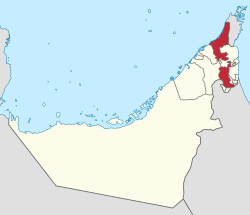Emirate of Ras Al Khaimah إِمَارَة رَأْس ٱلْخَيْمَة Ra's al-Khaymah | |
|---|---|
 Location of Ras Al Khaimah in the UAE | |
| Coordinates: 25°47′N55°57′E / 25.783°N 55.950°E | |
| Country | |
| Seat | Ras Al Khaimah |
| Government | |
| • Type | Islamic absolute monarchy within a federation |
| • Ruler | Saud bin Saqr Al Qasimi |
| • Crown Prince | Mohammed bin Saud Al Qasimi |
| Area | |
• Total | 2,454.46 km2 (947.67 sq mi) |
| • Rank | 4th |
| Population (2023) | |
• Total | 400,000 |
| • Rank | 5th |
| GDP | |
| • Total | US$ 14.3 billion (2023) |
| • Per capita | US$ 30,700 (2023) |
Ras Al Khaimah [a] is the northernmost of the seven emirates that make up the United Arab Emirates. The city of Ras Al Khaimah, abbreviated to RAK or RAK City, [2] is the capital of the emirate and home to most of the emirate's residents. It is linked to the Islamic trading port of Julfar, [3] [4] its predecessor settlement. Its name in English means "headland of the tent". [5] The emirate borders Oman's exclave of Musandam, and occupies part of the same peninsula. [4] [6] It covers an area of 2,486 km2 (960 sq mi) and has 64 km (40 miles) of beach coastline. As of 2023, the emirate had a population of about 400,000. [7]
Contents
- History
- Pirate coast
- Joining the United Arab Emirates
- Modern history
- List of rulers
- Demographics
- Towns and settlements
- Landmarks
- Dunes and landforms
- Climate
- Economy
- Main economic sectors
- Taxation and companies law
- Culture
- Events
- Infrastructure
- Transportation
- See also
- Notes
- References
- External links
The city of Ras Al Khaimah has two main areas — the Old Town and Nakheel — on either side of a creek that is home to mangroves and is framed by the North-Western Hajar Mountains. [6] The emirate also consists of several villages and new gated residential developments, such as Al Hamra Village and Mina Al Arab. The emirate is served by Ras Al Khaimah International Airport. Its geography consists of a northern part (where Ras Al Khaimah City and most towns are situated) and a large southerly inland exclave with an area of 866.50 km² and a population of 14,533 as of 2017 (near the Dubai exclave of Hatta), and a few small islands in the Persian Gulf. Ras Al Khaimah has the most fertile soil in the country, due to a larger share of rainfall and underground water streams from the Hajar Mountains, which overlook the city on the landward side.














